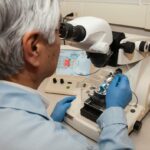The theory of evolution, a cornerstone of modern biology, offers a comprehensive explanation for the diversity and interconnectedness of life on Earth. Charles Darwin, its primary architect, proposed that all species descend from common ancestors through a process he termed “natural selection.” This theory, though initially met with skepticism, has since been bolstered by a wealth of evidence from various scientific disciplines. Understanding this evidence is crucial, not only for appreciating the grandeur of life’s history but also for making informed decisions about issues like antibiotic resistance, conservation, and genetic engineering.
Fossil Records: A Time Capsule of Evolution
Fossil records serve as a veritable time capsule, offering glimpses into the ancient past. They provide a chronological sequence of life forms, from simple, single-celled organisms to complex, multicellular ones. The consistency of this sequence, with older fossils being simpler and younger ones more complex, supports the evolutionary timeline.
Interestingly, there are no “anachronistic” fossils—fossils that appear out of their proper time. For instance, we do not find fossils of rabbits in Precambrian rocks, which predate the evolution of mammals. This absence of anachronistic fossils further corroborates the evolutionary sequence of life.
Comparative Anatomy: A Glimpse into Evolutionary Relationships
Comparative anatomy provides another layer of evidence for evolution. Homologous structures—body parts with similar structures but different functions—suggest a common ancestry. For example, the human arm, the wing of a bat, and the flipper of a whale all share a similar bone structure, pointing to a common ancestral mammal.
Vestigial structures, or remnants of structures that were functional in ancestral species, also support evolution. For instance, humans have a vestigial tailbone, a remnant of our primate ancestors’ tails. On the other hand, convergent evolution, where unrelated species develop similar traits due to similar environments, leads to analogous structures. The wings of bats and insects are an example of this phenomenon.
Genetic Evidence: The Blueprint of Evolution
Genetics has revolutionized our understanding of evolution. DNA sequencing reveals the genetic relatedness of species, confirming the relationships suggested by comparative anatomy. Moreover, genetic mutations, which introduce variation into populations, provide the raw material for natural selection.
The presence of shared genes across species further supports common ancestry. For instance, humans share about 98% of their genes with chimpanzees, our closest living relatives. This genetic similarity underscores our shared evolutionary history.
Biogeography: The Geographic Distribution of Species
Biogeography, the study of the geographic distribution of species, also provides evidence for evolution. The theory of continental drift, which explains the movement of Earth’s landmasses over geological time, has helped elucidate patterns of species distribution. For example, the unique fauna of Australia, such as marsupials, can be explained by its long isolation from other continents.
Island biogeography, in particular, offers compelling evidence for adaptive radiation, a process where a single species evolves into many different forms to exploit different ecological niches. The diverse finch species on the Galapagos Islands, studied by Darwin himself, exemplify this process.
Direct Observations of Evolutionary Change
Despite the common misconception, evolution is not just a theory but a process that can be directly observed. Bacterial resistance to antibiotics is a stark example of this. Overuse of antibiotics has led to the evolution of resistant strains, a pressing public health concern.
Similarly, the evolution of finches on the Galapagos Islands has been documented over several decades. Changes in beak size and shape in response to environmental changes provide a real-time glimpse into the process of evolution.
Embryology: Tracing Evolutionary Development
Embryology, the study of early developmental stages, offers further evidence for evolution. Many species show striking similarities in their embryonic stages, suggesting a common ancestry. For instance, human embryos have gill-like structures, reflecting our aquatic vertebrate ancestors.
Moreover, human embryos exhibit “evolutionary throwbacks,” such as a tail and fur-like hair, further supporting our evolutionary history.
Evolutionary Predictions Confirmed by Subsequent Discoveries
The predictive power of the theory of evolution is one of its most compelling aspects. For example, the prediction and subsequent discovery of Tiktaalik, a transitional fossil between fish and land-dwelling animals, bolstered our understanding of vertebrate evolution.
Similarly, evolutionary predictions about human chromosome 2, which appears to be a fusion of two ancestral ape chromosomes, were confirmed by genetic research. This finding provided further evidence for our common ancestry with apes.
Evolutionary Misconceptions and Controversies
Despite the overwhelming evidence, misconceptions and controversies about evolution persist. Many people misunderstand the term “theory” in a scientific context, equating it with a mere guess. However, in science, a theory is a well-substantiated explanation of some aspect of the natural world, backed by a body of evidence.
The controversy surrounding human evolution often stems from religious or philosophical beliefs. However, it’s important to note that many religious groups, including the Catholic Church, accept the scientific validity of evolution.
Closing Thoughts
Closing Thoughts, the theory of evolution, supported by a wealth of evidence from fossil records, comparative anatomy, genetics, biogeography, direct observations, embryology, and confirmed predictions, offers a comprehensive explanation for the diversity and interconnectedness of life. As our understanding of life’s complexity deepens, so does our appreciation for the elegant simplicity of the evolutionary process. The ongoing study of evolution continues to shed light on our place in the natural world and inform our decisions about pressing issues like antibiotic resistance, conservation, and genetic engineering.
Frequently Asked Questions
What is the theory of evolution?
The theory of evolution is a scientific explanation for the diversity and interconnectedness of life. It proposes that all species descend from common ancestors through a process called natural selection.
What evidence supports the theory of evolution?
Evidence for evolution comes from various scientific disciplines, including fossil records, comparative anatomy, genetics, biogeography, direct observations, embryology, and confirmed predictions.
What are homologous and vestigial structures?
Homologous structures are body parts with similar structures but different functions, suggesting a common ancestry. Vestigial structures are remnants of structures that were functional in ancestral species.
How does genetics support evolution?
Genetics supports evolution in several ways. DNA sequencing reveals the genetic relatedness of species. Genetic mutations introduce variation into populations, providing the raw material for natural selection. Shared genes across species further support common ancestry.
What is biogeography and how does it support evolution?
Biogeography is the study of the geographic distribution of species. It supports evolution by showing how species distribution patterns can be explained by historical events like continental drift and processes like adaptive radiation.
What are some misconceptions about evolution?
Some common misconceptions about evolution include the misunderstanding of the term “theory” in a scientific context and the controversy surrounding human evolution due to religious or philosophical beliefs.
References:
- Darwin, C. (1859). On the Origin of Species. John Murray.
- Futuyma, D. J., & Kirkpatrick, M. (2017). Evolution (4th ed.). Sinauer Associates.
- Gould, S. J. (1990). Wonderful Life: The Burgess Shale and the Nature of History. W. W. Norton & Company.
- Lamichhaney, S., Berglund, J., Almén, M. S., Maqbool, K., Grabherr, M., Martinez-Barrio, A., … & Grant, B. R. (2015). Evolution of Darwin’s finches and their beaks revealed by genome sequencing. Nature, 518(7539), 371-375.
- Shubin, N. (2008). Your Inner Fish: A Journey into the 3.5-Billion-Year History of the Human Body. Pantheon Books.
- Zimmer, C., & Emlen, D. J. (2015). Evolution: Making Sense of Life (2nd ed.). Roberts and Company Publishers.








